
 |
|---|
 |
 |
 |
 |
 |
 |
 |
 |
 |
 |
 |
 |
 |
 |
 |
 |
 |
Felling
Weald Woodscapes offers a comprehensive and professional felling service. Each member of the team has over 20 years’ experience felling in forestry, woodlands and amenity settings. Our combined skills and high level of experience as commercial ‘cutters’ enables the team to work to any management specification and also ensures that the felling work is undertaken to the highest and safest professional standards. Weald Woodscapes specialise in the management of Ancient Semi Natural Woodland (ASNW) and Plantations on Ancient Woodland Sites (PAWS).
Over the past 20 years we have worked on a wide range of woodland sites throughout the UK:
Coppice woodland
Gill woodland
Riparian woodland
Selective and line thinning operations.
Continuous cover systems
Weald Woodscapes can provide advice on felling regimes, thinning intensities and coppice rotations and is well versed in the art of selective thinning systems. As such, our aim is to ensure that trees are felled safely without incurring damage to retained standing crop any veteran trees or the wider woodland environment. We keep in mind both the intrinsic value of the tree, its role as neighbour to other trees and as part of the wooded community, whilst also recognising its potential as a timber product.
A sound team work ethic is a crucial factor when working a woodland and we are a team that has worked together for many years.
Each contractor holds the relevant Chainsaw Certificates (LANTRA) for felling and tree surgery
operations and complies with the FISA guidelines for each management task.
Weald Woodscapes is fully insured (Employers & Public Liability) and will also always provide detailed Site Safety and Risk Assessment documentation for every contract.


Why fell trees?
-
Reinstate, regenerate and manage coppice, pollards and stubs.
-
‘Halo’, release thin around ancient, veteran and notable trees.
-
Halo thinning to release and favour emergent groups of native or endemic tree species or individual specimen trees.
-
Reinstatement of thinning regime in under thinned conifer and broadleaved woodlands.
-
Woodland ride creation and management – to create ‘open space’ habitat and a zonal structure to rides and woodland edges.
-
Woodlands with high public access – removal of dangerous, diseased and wind blown trees
-
Tree health and disease control/management.
-
Thinning to favour final crop.
-
Initiating a thinning regime in secondary woodland to create an uneven age structure.
-
Income from felled timber produce.
Working to
enhance and
sustain the wise
use of woodlands
and timber